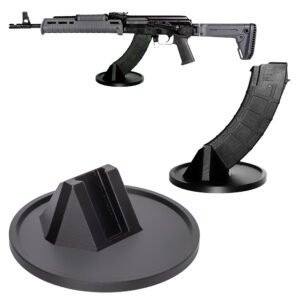
Categories:
The AR-10 platform, a predecessor to the AR-15, is a versatile and powerful rifle that has carved a niche for itself in a variety of shooting applications, ranging from competitive shooting to hunting and tactical operations. One of the critical components that ensure the smooth and reliable operation of this semi-automatic rifle is the gas block. Understanding the function and importance of the AR-10 gas block is essential for both novice shooters and seasoned gun enthusiasts.
At its core, the gas block plays a vital role in regulating the gas flow from the barrel to cycle the action of the gun. When a round is fired, a portion of the high-pressure gas produced by the burning gunpowder is diverted through a small hole, known as the gas port, in the barrel. This gas travels through a tube and reaches the gas block, where its flow is managed and directed.
By controlling the amount of gas entering the gas tube and, consequently, the bolt carrier group, the gas block ensures that the rifle functions reliably under different conditions.
The AR-10 gas block can be adjusted to allow more or less gas to flow into the gas tube, affecting the cycling of the action. This adjustability is crucial for fine-tuning the rifle, especially when using different types of ammunition or operating in varying environmental conditions. A properly adjusted gas block can significantly reduce recoil, improve accuracy, and prolong the lifespan of the rifle’s components by preventing excessive wear and tear.
Several types of gas blocks are available for the AR-10, including fixed, adjustable, and low-profile variants. Each type offers distinct advantages depending on the shooter’s specific needs. Fixed gas blocks provide a consistent flow of gas and are often simpler to install and maintain, making them an excellent choice for standard setups. Adjustable gas blocks offer greater control and customization, allowing shooters to tweak the gas flow for optimal performance with different loads and accessories.
Low-profile gas blocks are designed to fit under free-floating handguards, providing a sleek and streamlined appearance while still performing their essential function.
Understanding the intricacies of the AR-10 gas block is fundamental for anyone looking to get the most out of their rifle. By properly regulating the gas flow, the gas block ensures that the rifle operates smoothly, efficiently, and reliably, making it an indispensable component of the AR-10 platform.
In the realm of semi-automatic rifles, the AR-10 stands out for its robust performance and versatility. A critical component that enhances this performance is the gas block, which plays a pivotal role in regulating the gas flow from the barrel to cycle the action. The importance of gas regulation in AR-10 rifles cannot be overstated, as it directly impacts the reliability, accuracy, and overall functioning of the gun.
At the core of the AR-10’s operation, the gas system captures a portion of the high-pressure gases produced when a round is fired. These gases are redirected through a small port in the barrel and into the gas block. The gas block then channels these gases into the gas tube, ultimately driving the bolt carrier group (BCG) backward to cycle the action.
Proper gas regulation ensures that the correct amount of gas pressure is utilized to perform this task efficiently. Too much or too little gas can lead to a myriad of issues, affecting the rifle’s performance.
When the gas flow is not properly regulated, over-gassing or under-gassing can occur. Over-gassing results in an excessive amount of gas entering the system, causing the BCG to cycle too violently. This can lead to increased wear and tear on the rifle’s internal components, reduced accuracy over time, and more substantial recoil experienced by the shooter. On the other hand, under-gassing happens when insufficient gas reaches the BCG, causing it to short stroke.
This can result in failure to eject spent cartridges or failure to feed new rounds, severely compromising the rifle’s reliability in critical situations.
Optimizing gas regulation also enhances the shooting experience. By fine-tuning the gas block, shooters can achieve a smoother recoil impulse, which makes follow-up shots faster and more accurate. This is especially beneficial in competitive shooting environments and tactical situations where precision and speed are paramount. The ability to adjust the gas flow allows shooters to tailor the rifle’s operation to different types of ammunition and environmental conditions, further enhancing the rifle’s adaptability and performance.
In summary, the gas block’s role in regulating gas flow is fundamental to the AR-10’s functionality. Proper gas regulation not only safeguards the rifle’s longevity by preventing undue stress on its components but also ensures reliability and accuracy. For these reasons, understanding and maintaining optimal gas regulation is essential for anyone looking to maximize the performance of their AR-10 rifle.
When discussing gas blocks for the AR-10, it’s essential to delve into the types available, primarily adjustable versus non-adjustable gas blocks. Each type serves a distinctive purpose and caters to various shooting needs and preferences, influencing the rifle’s performance and the shooter’s overall experience.
Non-adjustable gas blocks, often referred to as fixed gas blocks, are the simpler and more traditional option. They are designed to deliver a constant, unalterable amount of gas from the barrel to the gas system, subsequently cycling the action. The primary benefit of a non-adjustable gas block is its straightforwardness and reliability. There are fewer moving parts involved, which typically translates to enhanced durability and lower maintenance.
Shooters who value consistency and simplicity often gravitate toward non-adjustable gas blocks because they provide a uniform gas flow, crucial for the weapon’s consistent performance in various conditions. This type also tends to be more cost-effective, making it a popular choice for those seeking a budget-friendly yet dependable solution.
On the other hand, adjustable gas blocks offer a higher level of customization by allowing the user to modulate the amount of gas flow. This adaptability can significantly affect the gun’s cycling, recoil, and overall smoothness of operation. Adjusting the gas flow can be particularly beneficial in finely tuning the rifle when using different types of ammunition or suppressors. Suppressors tend to increase the back pressure in the system, and an adjustable gas block can help mitigate that by reducing the gas flow, thereby lowering recoil and wear on critical components.
Competitive shooters and enthusiasts who dabble in precision shooting often favor adjustable gas blocks for their fine-tuning capabilities. This flexibility allows them to tailor the gas system for optimal performance, enhancing accuracy and reliability across various shooting scenarios. However, this type can be slightly more complex and require additional maintenance over time due to the moving parts and possible carbon buildup in the adjustment mechanism.
Both adjustable and non-adjustable gas blocks have their merits and are designed to meet different operational requirements. Choosing between the two largely hinges on the shooter’s priorities and intended use. Whether you value the steadfastness of a non-adjustable gas block or the versatile tuning of an adjustable one, understanding these distinctions will guide you in making an informed decision tailored to your rifle’s needs and your shooting style.
The gas block of an AR-10 plays a crucial role in the reliable functioning of the gun by ensuring the precise control of gas flow from the barrel to cycle the action. Understanding the mechanism and functionality of the gas block sheds light on its importance for consistent performance and customization.
In the AR-10, gases generated by the combustion of gunpowder are essential for its semi-automatic operation. As a round is fired, gases are expelled from the cartridge, propelling the bullet down the barrel. A portion of these gases is then diverted through a small hole, called the gas port, located in the barrel. The gas block is mounted over this gas port and serves as an intermediary between the barrel and the gas tube, directing the flow of these gases into the gas tube, which then channels the gas back towards the bolt carrier group (BCG).
The gas block’s primary function is to regulate the amount of gas that is redirected from the barrel to the gas tube. This regulation is crucial because too much gas can result in excessive recoil, premature wear of components, and unreliable cycling due to over-functioning, whereas too little gas can cause the gun to under-cycle, leading to failure in extracting or chambering the next round.
The ideal balance ensures that the bolt carrier group has enough energy to complete its cycle of operation, which includes extracting the spent cartridge, ejecting it, and chambering a new round, while also minimizing unnecessary stress on the gun components.
Adjustable gas blocks have become a popular choice among AR-10 users because they offer the ability to fine-tune the gas flow to the user’s specific needs. By turning an adjustment screw on the gas block, shooters can modify the size of the gas port opening. This feature is particularly useful in scenarios where the gun is being used with different types of ammunition, suppressors, or under varying environmental conditions.
Adjusting the gas block can help in achieving an optimal balance of performance, reliability, and recoil management tailored to the user’s preferences and the specific setup of their weapon.
Through its regulation of gas flow, the gas block ensures the AR-10 operates smoothly, reliably cycling the action with each shot while reducing the wear and tear on its components. This delicate balance orchestrated by the gas block directly impacts the gun’s accuracy, longevity, and overall user experience.
The installation and adjustment of the AR-10 gas block are crucial steps to ensure your rifle functions reliably and efficiently. Begin by ensuring that your rifle is unloaded and all ammunition is safely stored away. This is a matter of paramount importance for your safety and those around you. Once you have confirmed that the rifle is unloaded, place it on a stable work surface and gather the necessary tools, including an AR wrench, Allen wrenches, and a torque wrench.
First, you need to remove the existing gas block and gas tube. To do this, you may have to take off the handguard to access the gas block. Loosen the set screws or roll pins that secure the gas block to the barrel and gently slide it off, ensuring that you do not damage the gas tube in the process. Clean the barrel’s gas port area to remove any residues or carbon build-up that could affect the performance of your new gas block.
Next, slide the new gas block onto the barrel, ensuring that the gas port on the block aligns precisely with the gas port on the barrel. Misalignment can cause poor cycling or malfunctioning of the rifle. If your gas block has a set screw design, lightly tighten the screws to hold it in place temporarily. For clamp-on styles, ensure they are positioned correctly before torquing them down.
Inject a small amount of thread locker on the set screws or clamp screws to ensure they remain secure during firing.
The gas tube should now be inserted into the gas block. Ensure that the roll pin holes are aligned and drive in the roll pin to secure the gas tube. Reassemble the handguard before proceeding to the adjustment phase.
The goal of adjusting an adjustable gas block is to find the optimal gas flow that ensures reliable cycling without over-gassing or under-gassing the rifle. Start by turning the adjustment screw to its fully open position, then fire a few test rounds to see if the rifle cycles properly. Gradually reduce the gas flow by turning the screw in small increments and fire a few rounds after each adjustment.
The ideal setting will allow the rifle to cycle reliably with your chosen ammunition while minimizing recoil. Once this setting is found, tighten any locking mechanisms to ensure the adjustment stays in place.
Proper installation and adjustment of the gas block can significantly enhance the performance and longevity of your AR-10 rifle, providing you with a reliable and enjoyable shooting experience.
When dealing with gas block issues on an AR-10, several common problems can arise, affecting the gun’s performance and reliability. One prevalent issue is improper gas block alignment. If the gas block is not correctly aligned with the barrel’s gas port, it can result in irregular or insufficient gas flow, leading to failures in cycling the action. Ensuring correct alignment involves carefully checking that the gas block is centered over the gas port and properly secured.
Another frequent problem is gas leakage. Over time, carbon buildup can accumulate between the gas block and the barrel, or the gas block itself can develop small cracks or wear out, resulting in gas escaping before it can cycle the action. To address gas leakage, it’s essential to regularly inspect and clean the gas block and its components. One may also apply a high-temperature gasket sealant to enhance the seal between the gas block and the barrel.
Restricted gas flow due to a clogged gas port can also cause cycling issues. Carbon fouling and debris can obstruct the gas port, reducing the amount of gas that reaches the gas block. Removing the gas block and thoroughly cleaning both the gas port on the barrel and the inside of the gas block can alleviate this problem. Utilizing pipe cleaners or specialized tools designed for cleaning gas ports ensures the removal of obstructions without causing damage.
Another factor to consider is the gas block’s adjustable settings, if available. Adjustable gas blocks allow shooters to fine-tune the amount of gas flowing through the system, but incorrect adjustments can lead to malfunctions. If the gas block is set to allow too little gas, the action may not cycle correctly, resulting in failure to feed or eject rounds. Conversely, too much gas can cause excessive wear and tear on internal components.
To troubleshoot, readjust the gas block incrementally and test the gun after each adjustment to achieve optimal performance.
Finally, using the wrong type of ammunition might create issues if the ammunition does not produce the necessary pressure to cycle the action efficiently. Verify that you are using ammunition that meets the specifications recommended for your AR-10. Regular maintenance, careful alignment, and correct adjustments are critical to ensuring your AR-10 operates smoothly and reliably. If these troubleshooting steps do not resolve the issue, consulting with a professional gunsmith might be needed for further diagnosis and repair.
Maintaining and ensuring the proper function of the gas block on your AR10 is crucial for the reliable cycling of your gun’s action. Regular maintenance and upkeep should be part of your routine to avoid malfunctions and prolong the life of your rifle. The gas block, a component that diverts a portion of gas from the barrel to cycle the action, is subjected to intense pressure and temperature variations, which can lead to carbon build-up and potential blockages if not properly cleaned and maintained.
Begin by safely disassembling your AR10, making sure the weapon is unloaded and the bolt is locked back. Remove the handguard to expose the gas block. Depending on your specific model, the gas block may be held in place with set screws, clamps, or taper pins. Carefully remove these fasteners and slide the gas block off the barrel, being mindful not to lose any small parts like springs or detents.
Once the gas block is removed, perform a thorough inspection. Look for any signs of wear, corrosion, or damage. Carbon and residue buildup are common, especially if you use your rifle frequently or it gets exposed to adverse conditions. Use a solvent-soaked cloth to wipe away loose debris. For more stubborn carbon deposits, a brass brush or dental pick can be useful, but take care to avoid scratching or damaging the gas block’s surface.
Pay particular attention to the gas port and the gas tube where even minor blockages can affect the performance. A pipe cleaner or similar tool can be effective for cleaning inside the gas tube. Ensure the gas block’s internal passages are significantly clear; any impediment here can disrupt the correct gas flow and impair the cycling of the rifle.
Reassemble the gas block, aligning it correctly with the barrel’s gas port to ensure proper function. When fastening it back in place, apply thread locker to the screws to prevent loosening due to vibration. Check your work to ensure everything is snug and correctly positioned, as even slight misalignment can lead to gas leakage and cycling issues.
Regularly maintained gas blocks not only enhance performance but also help in identifying early signs of wear or potential issues before they turn into more significant problems. By incorporating gas block maintenance into your regular cleaning routine, you ensure the reliability and longevity of your AR10, allowing it to function optimally whenever you need it.








Colt
Colt M4 Carbine
Colt LE6920
Colt AR-15 A4
Daniel Defense
DDM4 V7
DDM4 V9
DDM4 V11
DDM4 ISR (Integrally Suppressed Rifle)
Smith & Wesson (S&W)
M&P15 Sport II
M&P15 Tactical
M&P15T
Bravo Company Manufacturing (BCM)
BCM Recce-16
BCM Recce-14
BCM MCMR Series
Aero Precision
M4E1 Series
AC-15
AR15 Pistol (Various Configurations)
Ruger
Ruger AR-556
Ruger SR-556
Ruger AR-556 MPR (Multi-Purpose Rifle)
Springfield Armory
Saint Victor
Saint Edge
Saint AR-15
PSA (Palmetto State Armory)
PSA PA-15
PSA AR-V
PSA Jakl (AR Pistol)
FN America
FN 15 Tactical Carbine
FN 15 Patrol
FN 15 DMR
Wilson Combat
Recon Tactical
Super Sniper
Protector Carbine
SIG Sauer
SIG M400 Tread
SIG M400 Elite
SIG M400 SDI
LWRC International
IC DI (Direct Impingement)
IC SPR
IC A5
Bushmaster Guns
XM-15 QRC
Bushmaster MOE
XM-15 Patrolman
Rock River Arms
LAR-15 Entry Tactical
LAR-15 Predator
LAR-15 Elite Comp
Stag Arms
Stag 15 Tactical
Stag 15L (Left-Handed Models)
Stag 15 Valkyrie
Noveske Rifleworks
Noveske Gen 4 N4
Noveske Space Invader (AR Pistol)
Noveske Recon
Anderson Manufacturing
AM-15 Optic Ready
AM-15 M4 Carbine
AM-15 Precision Rifle
Adams Arms
AA-15 Piston Rifle
P2 AARS (Adams Arms Rifle Series)
Black Rain Ordnance
SPEC15 Series
BRO Predator
Fallout 15
Diamondback Guns
DB15 Series
DB15CCMLB
DB15EB
Del-Ton Inc.
DTI-15
Del-Ton Echo 316H
Sierra 316M
Windham Weaponry
Windham SRC
Windham VEX-SS
Windham RMCS-4 (Caliber Conversion System)
Christensen Arms
CA-15 G2
CA-15 Recon
CA-15 Titanium Edition
Patriot Ordnance Factory (POF-USA)
Renegade Plus
P415 Edge
Revolution DI
LaRue Tactical
PredatAR
OBR (Optimized Battle Rifle)
LaRue Stealth 2.0
Battle Arms Development
Workhorse Patrol Carbine
BAD556-LW (Lightweight)
Authority Elite Rifle
Faxon Guns
Ascent AR-15
FX-19 (AR Pistol)
Streamline Ultralight Series
KE Arms
KE-15 SLT (Super Lightweight Tactical)
KE-15 Scout Carbine
Primary Weapons Systems (PWS)
MK1 MOD 2-M
MK116 PRO
MK107 (Piston AR Pistol)
ZEV Technologies
ZEV Core Elite Rifle
ZEV AR15 Billet Rifles
Franklin Armory
BFSIII AR-C1
Militia Model
F17-L (Chambered in .17 WSM)
Seekins Precision
SP15 DMR
NX15 Skeletonized Rifle
Havak Bravo
Aero Precision (Additional Models)
EPC-9 (Pistol Caliber ARs)
VG6 AR Rifles
Barrett Guns
REC7 DI
REC7 Gen II
CMMG
MK4 RCE
Resolute 300
Banshee (AR Pistol)
DPMS Panther Arms
Panther Oracle
Panther LR-308
H&K (Heckler & Koch)
HK MR556A1
HK416 (Military Variant)
Rock Island Armory (Armscor)
VR-80 Tactical AR (Shotgun AR Platform)
Troy Industries
Troy SPC-A3
Troy PAR (Pump Action AR)
Wilson Tactical
Tactical Recon AR
Protector Series
F1 Guns
FDR-15 Skeletonized Rifle
BDRx-15 Series
Juggernaut Tactical
JT-15
JT-10 Precision Rifle
AeroSurplus
Surplus AR-15 Rifles (Budget Models)
Thunder Tactical
AR-15 Basic Carbine
Tactical Builder Sets
Radical Guns
RF-15
Forged AR-Series
Dark Storm Industries
DS-15 Featureless Rifles
DS-10 Typhoon
DRD Tactical
Paratus
Aptus AR Rifles
Bear Creek Arsenal
BCA-15
AR Complete Upper Builds
Aero Survival Rifles (ASI)
ASR Tactical Series
Tactical Edge
WARFIGHTER Series
AR-15 Lightweight Rifles
Lone Star Armory
TX15 DMR
TX15 Carbine
HERA Arms
HERA H7
HERA AR-15 Lower Builds
IWI (Israeli Weapon Industries)
Zion-15
DRD Tactical
Tactical Modular Rifles
Quick-Takedown Rifles
V Seven Weapons
1776 Rifle
Hyperlite Rifle
Core Rifle Systems
Core15 Tac III
Core15 Patrol Rifle
Armalite (Original AR-15 Creator)
M15 Tactical
M15 A4 Carbine
DEF15 (Defensive Sporting Rifle Series)
PSA (Palmetto State Armory Additional Models)
PSAK-47 Hybrid (AR-AK Style Hybrid)
PSA Dagger (Pistol Caliber Configurations)
Odin Works
OTR-15
Odin Recon Rifle
Maxim Defense
MDX-508 PDX (Compact AR Pistol)
MDX-510 Rifle